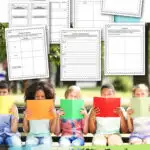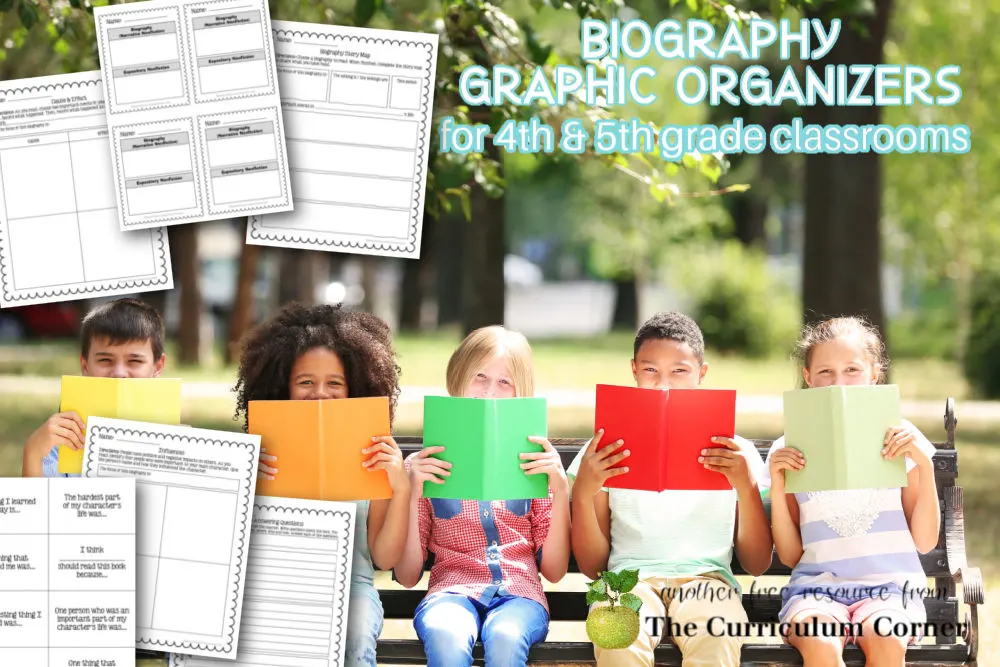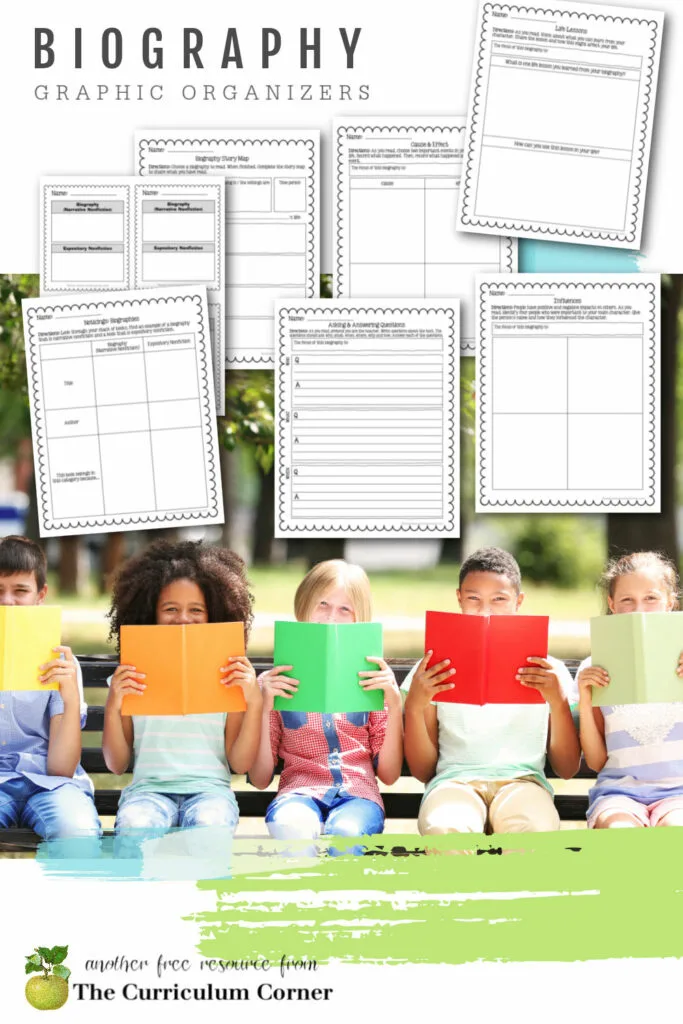Use this collection of biography graphic organizers to help your fourth and fifth grade students explore biographies during reading workshop.
These biography graphic organizers will be a helpful tool for you as you are planning your biography unit of study.
This is another free resource for teachers and homeschool families from The Curriculum Corner.
Planning for a study of biographies
As you plan for your unit of study, your first action should be gathering high interest biographies for your students to explore.
These mentor texts should be good, clear examples of biographies. Include your favorites and be sure to include books that will interest your students as well. It’s also a good idea to gather a stack of informational text books that fall under that category of narrative nonfiction. Throughout the unit, you might want to refer to these as nonexamples of biographies.
There are many informational text picture books that are written at a fourth to sixth grade level. This means that you should be able to find some shorter texts that will still challenge your readers. This can be helpful when you want students to explore multiple biographies.
As you work to gather your books, ask students who they would be most interested in learning about. Try to find books that match their requests to keep them engaged in the unit.
If you have a student interested in a subject but are unable to find a book to share, you can turn this into a follow up project. Have the student write their own biography about the subject. You can add this to your classroom librarym .
About these biography graphic organizers
This collection contains a variety of biography graphic organizers. You can choose to use the ones that fit your students best.
As always, I encourage you to model these organizers as you introduce them. This will help students to fully understand the expectations.
Lesson 1 Expository or Narrative Nonfiction?
Begin by helping students understand that there is a different between expository nonfiction and narrative nonfiction. Biographies fall under the category of narrative nonfiction and tell a story. Narrative nonfiction may also tell about an event. Expository nonfiction provides an explanation or directions.
This first lesson is designed to help students develop an understanding of the difference between a biography (which is narrative nonfiction) and expository nonfiction.
Share the stack of mentor texts along with the nonexamples of biographies (which should be expository nonfiction.)
Allow students time to look through these books and “notice” differences. Encourage them to make notes on post-its and mark the spots in the text.
These differences will help students begin to develop an understanding of the differences. When students have completed their noticings, pull them together as a class and give them time to share what they found.
Create an anchor chart for students to refer to that is titled “Noticings” and contains the student observations. Observations for biographies might include: tells a story, tells about a person’s life, includes dates, has bold words, has a table of contents, includes a glossary, has an index.
Observations for expository nonfiction might include: gives directions, tells all about an object or animal, explains something, includes dates, has bold words, has a table of contents, includes a glossary, has an index.
Noticings Exit Ticket To check student understanding, have students complete this exit ticket. Students find a biography and an example of expository nonfiction. They then include their choices and reasoning on their exit ticket.
Lesson 2 Biography Story Map
A biography can be similar to a fiction book which tells a story.
It includes a main character, setting, time and often problems.
Have students choose a biography to read and complete this story map.
You might choose to model this lesson by reading aloud a biography one day and completing the story map together.
The next day, students will use their silent reading time to read a different biography they are interested in and then complete the story map.
Lesson 3 Character Traits
Just like when reading fiction, students reading biographies should be trying to determine the character traits of the subject of the biography.
It is important for students to understand that character traits are different from what the person looks like. These resources can be used to help students develop an understanding of the difference: Character Traits.
We suggest using a biography that can be shared during class in order to model the differences for students. Once students have developed an understanding, they can complete their own graphic organizer after reading a just right book during silent reading time.
Lesson 4 Influences
Every person has others who influence his or her life.
These people have positive and negative effects on the character in a book.
For this lesson, focus on how other people in the biography have had an impact on the person.
Students will identify what influence the person had and if the influence was positive, negative or both.
It will be necessary for you to model this with the class in order for students to understand the expectations.
Once a model has been completed with the class, you can have students complete their own graphic organizer during independent reading time.
Lesson 5 Taking Notes While Reading
When reading a biography, it is sometimes important for the reader to take notes so that they remember the important facts.
This organizer can be used for a tool that helps students record the facts in the book.
Lesson 6 Reflections
An important part of reading is thinking about what is being read.
Use these cards to encourage students to think about the person they are reading about.
You can print the page on cardstock and then laminate for durability.
Or, you can print on regular paper and have students choose a question. They can record their response on the back like an exit ticket.
Lesson 7 Asking and Answering Questions
Readers ask and answer questions in their heads as they read to help them create meaning.
This graphic organizer gives students practice with this skill while asking them to record their thoughts.
You may choose to have students answer their own questions or to trade with a peer who is reading the same book.
Lesson 8 Cause & Effect
This is a concept which will take a great deal of modeling.
Students must understand that events in a person’s life lead to outcomes.
As you read a biography, work with the class to find important events in a person’s life and the impact those events had on the person.
As part of this work, help students identify where the answers are.
When students practice this skill independently, you might choose to have them use a post-it note to mark the evidence found in the text.
Lesson 9 Life Lessons
Sometimes reading a biography might teach us lessons we can apply to our own lives.
Encourage students to look at the book they are reading and determine what they can learn from their character.
These lessons might be positive or negative.
You can download this set of biography graphic organizers here:
CCSS Standards Addressed:




Preparing Your Reading Workshop - The Curriculum Corner 123
Thursday 20th of June 2019
[…] Biographies Collection for 4th and 5th Grades […]
Biography Unit of Study for Reading - The Curriculum Corner 123
Monday 27th of May 2019
[…] you need additional resources for enrichment or differentiation you might want to check out the Biographies – Resources from our 456 […]
Jivey
Monday 14th of April 2014
This is a fabulous post! I hope you don't mind, I'm going to link to this page on Wednesday when I share about biographies on my blog, too! :) :)